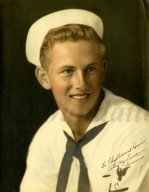
|

|
|
|
|
Thomas was born at home on Egan Street in Shreveport to Thomas V. Hannigan and Delta Edna Taylor Hannigan. The elder Hannigan, a former merchant marine, was a plumber who made about $30 a week in the Depression. During Thomas's early years, the family lived in a one-room apartment where his mother cooked on a two-burner hot plate. They later moved into a former grocery store remodeled as a residence. Meanwhile, Thomas helped his dad in plumbing projects. Beginning at age 13, he held odd jobs to supplement the family income as a paperboy as well as a carhop and soda jerk at Centenary Drugs. Church was a central part of the family life. The Hannigans attended Southside Baptist Church. Thomas was working for Beach's Plumbing Company and worked at Barksdale Air Field, replacing gas lines as World War II began. He accompanied his father to McGehee, Arkansas to work at a Japanese detention center. "I felt sorry for them, you know, because they were all Americans," he says. Thomas served a four-year apprenticeship as a plumber and earned his state license. In May of 1942 he graduated from Byrd High School where he had been a member of ROTC. On September 15, 1942, he married Phyllis Beatrice McRee. (They would have four children.) Her father, a railroad employee, helped Thomas obtain a job as a yard clerk for L&A Railroad, where he worked for two months before entering the U.S. Navy Seabees. After boot camp at Camp Peary near Williamsburg, Virginia, he joined Underwater Demolition Team (UDT) and trained in explosives and diving. After additional training at Fort Pierce, and at Maui in Hawaii, his unit, UDT4, sailed aboard the USS Typhoon to the Solomon Islands. Before the invasion of Pacific islands, Thomas and UDT4 rigged explosives to demolish underwater barriers that Japanese had erected to hinder invasion craft. He participated in the invasions of Saipan, Guam, Tinian, Leyte and Okinawa. Each diver wore only canvas shorts, shoes, a glass facemask, and a belt with a nine-inch knife. Each swam with four explosives on straps over each shoulder. Most of their work was done under fire from Japanese. "On Guam it took us four days to get the obstacles out of the way," he says. Once, Thomas was still in the water when an officer ignited a primer cord connected to explosives. "I went straight up in the air," he recalls. Thomas was wounded during the Leyte invasion when shrapnel sliced into his arm, and rescued in a rubber raft after his landing craft was sunk by enemy fire. After recuperation and additional training on Maui, he accompanied his unit to Okinawa, where he worked in the water four days, two to four hours at a time. Water temperature, he recalls, "was about fifty degrees." To stay warm, the swimmers covered their bodies with grease and silver paint that held the grease together. "I guess we probably covered over a mile of beach," he recalls in destroying Japanese obstacles. Thomas and his unit returned to the States after Okinawa, reaching the Golden Gate Bridge on July 4, 1945. After a 30-day leave in Shreveport he was aboard a destroyer bound for Okinawa to prepare for the invasion of Japan when the war ended. The ship returned to California where Thomas remained until his discharge on December 23, 1945. Thomas returned to his plumbing career. Phyllis passed away in 1983. He is currently married to Amelia Ann Adcock Hannigan. Thomas works for Shreveport-Bossier Rescue Mission and the Food Bank of Northwest Louisiana, as well as with senior citizens at Broadmoor Baptist Church. |


